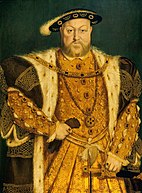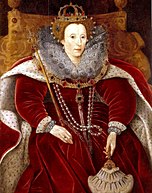England
England

 From Wikipedia, the free encyclopedia
From Wikipedia, the free encyclopedia
This article is about the country. For other uses, see England (disambiguation).
England Flag
Flag
Anthem: Various
Predominantly "God Save the King"
(National anthem of the United Kingdom)
Location of England (dark green)
– in Europe (green & dark grey)
– in the United Kingdom (green)
StatusCountryCapital
and largest city
London 51°30′N 0°7′WNational languageEnglishRegional languagesCornishEthnic groups (2021)[1]show
51°30′N 0°7′WNational languageEnglishRegional languagesCornishEthnic groups (2021)[1]show
List
Religion (2021)[1]show
List
GovernmentPart of a constitutional monarchy, direct government exercised by the UK Government• Monarch
Charles IIIParliament of the United Kingdom• House of Commons533 MPs (of 650)Establishment• Unification of Angles, Saxons and Danes
by 12 July 927• Union with Scotland
1 May 1707Area• Total[a]
132,930 km2 (51,320 sq mi)[2]• Land[b]
130,310 km2 (50,310 sq mi)[2]Population• Mid-2021 estimate 56,536,419[3]• 2021 census
56,536,419[3]• 2021 census 56,490,048[1]• Density
56,490,048[1]• Density
434/km2 (1,124.1/sq mi)[3]GVA2021 estimate • Total£1.760 trillion • Per capita£31,138[4]GDP (nominal)2021 estimate• Total
£1.961 trillion• Per capita
£34,690[5]CurrencyPound sterling (GBP; £)Time zoneUTC+0 (Greenwich Mean Time)• Summer (DST)
UTC+1 (British Summer Time)Date formatdd/mm/yyyy (AD)Driving sideleftCalling code+44ISO 3166 codeGB-ENG
England is a country that is part of the United Kingdom.[6] The country is located on the island of Great Britain, of which it covers roughly 62%, and over 100 smaller adjacent islands. It has land borders with Scotland to the north and Wales to the west, and is otherwise surrounded by the North Sea to the east, the English Channel to the south, the Celtic Sea to the south-west, and the Irish sea to the west. Continental Europe lies to the south-east, and Ireland to the west. The population was 56,490,048 at the 2021 census. London is both the largest city and the capital.
The area now called England was first inhabited by modern humans during the Upper Paleolithic, but takes its name from the Angles, a Germanic tribe who settled during the 5th and 6th centuries. England became a unified state in the 10th century and has had a significant cultural and legal impact on the wider world since the Age of Discovery, which began during the 15th century.[7] The Kingdom of England, which included Wales after 1535, ceased being a separate sovereign state on 1 May 1707 when the Acts of Union put the terms agreed in the Treaty of Union the previous year into effect; this resulted in a political union with the Kingdom of Scotland that created the Kingdom of Great Britain.[8]
England is the origin of many well-known worldwide exports, including the English language, the English legal system (which served as the basis for the common law systems of many other countries), association football, and the Church of England; its parliamentary system of government has been widely adopted by other nations.[9] The Industrial Revolution began in 18th-century England, transforming its society into the world's first industrialised nation.[10] England is home to the two oldest universities in the English-speaking world: the University of Oxford, founded in 1096, and the University of Cambridge, founded in 1209. Both universities are ranked among the most prestigious in the world.[11][12]
England's terrain chiefly consists of low hills and plains, especially in the centre and south. Upland and mountainous terrain is mostly found in the north and west, including Dartmoor, the Lake District, the Pennines, and the Shropshire Hills. The country's capital is London, the greater metropolitan of which has a population of 14.2 million as of 2021, representing the United Kingdom's largest metropolitan area. England's population of 56.3 million comprises 84% of the population of the United Kingdom,[13] largely concentrated around London, the South East, and conurbations in the Midlands, the North West, the North East, and Yorkshire, which each developed as major industrial regions during the 19th century.[14]
Toponymy
See also: Toponymy of England
The name "England" is derived from the Old English name Englaland, which means "land of the Angles".[15] The Angles were one of the Germanic tribes that settled in Great Britain during the Early Middle Ages. The Angles came from the Anglia peninsula in the Bay of Kiel area (present-day German state of Schleswig-Holstein) of the Baltic Sea.[16] The earliest recorded use of the term, as "Engla londe", is in the late-ninth-century translation into Old English of Bede's Ecclesiastical History of the English People. The term was then used to mean "the land inhabited by the English", and it included English people in what is now south-east Scotland but was then part of the English kingdom of Northumbria. The Anglo-Saxon Chronicle recorded that the Domesday Book of 1086 covered the whole of England, meaning the English kingdom, but a few years later the Chronicle stated that King Malcolm III went "out of Scotlande into Lothian in Englaland", thus using it in the more ancient sense.[17]
The earliest attested reference to the Angles occurs in the 1st-century work by Tacitus, Germania, in which the Latin word Anglii is used.[18] The etymology of the tribal name itself is disputed by scholars; it has been suggested that it derives from the shape of the Angeln peninsula, an angular shape.[19] How and why a term derived from the name of a tribe that was less significant than others, such as the Saxons, came to be used for the entire country is not known, but it seems this is related to the custom of calling the Germanic people in Britain Angli Saxones or English Saxons to distinguish them from continental Saxons (Eald-Seaxe) of Old Saxony in Germany.[20] In Scottish Gaelic, the Saxon tribe gave their name to the word for England (Sasunn);[21] similarly, the Welsh name for the English language is "Saesneg". A romantic name for England is Loegria, related to the Welsh word for England, Lloegr, and made popular by its use in Arthurian legend. Albion is also applied to England in a more poetic capacity,[22] though its original meaning is the island of Britain as a whole.
History
Main article: History of England
For a chronological guide, see Timeline of English history.
Prehistory and antiquity
Main article: Prehistoric Britain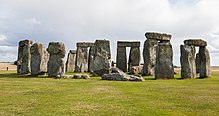
The earliest known evidence of human presence in the area now known as England was that of Homo antecessor, dating to approximately 780,000 years ago. The oldest proto-human bones discovered in England date from 500,000 years ago.[23] Modern humans are known to have inhabited the area during the Upper Paleolithic period, though permanent settlements were only established within the last 6,000 years.[24] After the last ice age only large mammals such as mammoths, bison and woolly rhinoceros remained. Roughly 11,000 years ago, when the ice sheets began to recede, humans repopulated the area; genetic research suggests they came from the northern part of the Iberian Peninsula.[25] The sea level was lower than the present day and Britain was connected by land bridge to Ireland and Eurasia.[26] As the seas rose, it was separated from Ireland 10,000 years ago and from Eurasia two millennia later.
The Beaker culture arrived around 2,500 BC, introducing drinking and food vessels constructed from clay, as well as vessels used as reduction pots to smelt copper ores.[27] It was during this time that major Neolithic monuments such as Stonehenge (phase III) and Avebury were constructed. By heating together tin and copper, which were in abundance in the area, the Beaker culture people made bronze, and later iron from iron ores. The development of iron smelting allowed the construction of better ploughs, advancing agriculture (for instance, with Celtic fields), as well as the production of more effective weapons.[28] The Battersea Shield is one of the most significant pieces of ancient Celtic art found in Britain.
The Battersea Shield is one of the most significant pieces of ancient Celtic art found in Britain.
During the Iron Age, Celtic culture, deriving from the Hallstatt and La Tène cultures, arrived from Central Europe. Brythonic was the spoken language during this time. Society was tribal; according to Ptolemy's Geographia there were around 20 tribes in the area. Like other regions on the edge of the Empire, Britain had long enjoyed trading links with the Romans. Julius Caesar of the Roman Republic attempted to invade twice in 55 BC; although largely unsuccessful, he managed to set up a client king from the Trinovantes.
The Romans invaded Britain in 43 AD during the reign of Emperor Claudius, subsequently conquering much of Britain, and the area was incorporated into the Roman Empire as Britannia province.[29] The best-known of the native tribes who attempted to resist were the Catuvellauni led by Caratacus. Later, an uprising led by Boudica, Queen of the Iceni, ended with Boudica's suicide following her defeat at the Battle of Watling Street.[30] The author of one study of Roman Britain suggested that from 43 AD to 84 AD, the Roman invaders killed somewhere between 100,000 and 250,000 people from a population of perhaps 2,000,000.[31] This era saw a Greco-Roman culture prevail with the introduction of Roman law, Roman architecture, aqueducts, sewers, many agricultural items and silk.[32] In the 3rd century, Emperor Septimius Severus died at Eboracum (now York), where Constantine was subsequently proclaimed emperor a century later.[33]
There is debate about when Christianity was first introduced; it was no later than the 4th century, probably much earlier. According to Bede, missionaries were sent from Rome by Eleutherius at the request of the chieftain Lucius of Britain in 180 AD, to settle differences as to Eastern and Western ceremonials, which were disturbing the church. There are traditions linked to Glastonbury claiming an introduction through Joseph of Arimathea, while others claim through Lucius of Britain.[34] By 410, during the decline of the Roman Empire, Britain was left exposed by the end of Roman rule in Britain and the withdrawal of Roman army units, to defend the frontiers in continental Europe and partake in civil wars.[35] Celtic Christian monastic and missionary movements flourished. This period of Christianity was influenced by ancient Celtic culture in its sensibilities, polity, practices and theology. Local "congregations" were centred in the monastic community and monastic leaders were more like chieftains, as peers, rather than in the more hierarchical system of the Roman-dominated church.[36]
Middle Ages
Main article: England in the Middle Ages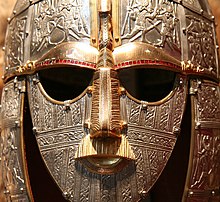 Replica of the 7th-century ceremonial Sutton Hoo helmet from the Kingdom of East Anglia
Replica of the 7th-century ceremonial Sutton Hoo helmet from the Kingdom of East Anglia
Roman military withdrawals left Britain open to invasion by pagan, seafaring warriors from north-western continental Europe, chiefly the Saxons, Angles, Jutes and Frisians who had long raided the coasts of the Roman province. These groups then began to settle in increasing numbers over the course of the fifth and sixth centuries, initially in the eastern part of the country.[35] Their advance was contained for some decades after the Britons' victory at the Battle of Mount Badon, but subsequently resumed, overrunning the fertile lowlands of Britain and reducing the area under Brittonic control to a series of separate enclaves in the more rugged country to the west by the end of the 6th century. Contemporary texts describing this period are extremely scarce, giving rise to its description as a Dark Age. Details of the Anglo-Saxon settlement of Britain are consequently subject to considerable disagreement; the emerging consensus is that it occurred on a large scale in the south and east but was less substantial to the north and west, where Celtic languages continued to be spoken even in areas under Anglo-Saxon control.[37][38]
The early Anglo-Saxon period includes the creation of an English nation, with many of the aspects that survive today, including regional government and shires. Christianity was established with a great flowering of literature and language.[39] Charters and laws were also established with a sophisticated justice system.[40][41] Roman-dominated Christianity had, in general, been replaced in the conquered territories by Anglo-Saxon paganism, but was reintroduced by missionaries from Rome led by Augustine from 597.[42][36]
During the settlement period the lands ruled by the incomers seem to have been fragmented into numerous tribal territories, but by the 7th century, when substantial evidence of the situation again becomes available, these had coalesced into roughly a dozen kingdoms including Northumbria, Mercia, Wessex, East Anglia, Essex, Kent and Sussex. Over the following centuries, this process of political consolidation continued.[43] The 7th century saw a struggle for hegemony between Northumbria and Mercia, which in the 8th century gave way to Mercian preeminence.[44] In the early 9th century Mercia was displaced as the foremost kingdom by Wessex. Later in that century escalating attacks by the Danes culminated in the conquest of the north and east of England, overthrowing the kingdoms of Northumbria, Mercia and East Anglia. Wessex under Alfred the Great was left as the only surviving English kingdom, and under his successors, it steadily expanded at the expense of the kingdoms of the Danelaw. This brought about the political unification of England, first accomplished under Æthelstan in 927 and definitively established after further conflicts by Eadred in 953. A fresh wave of Scandinavian attacks from the late 10th century ended with the conquest of this united kingdom by Sweyn Forkbeard in 1013 and again by his son Cnut in 1016, turning it into the centre of a short-lived North Sea Empire that also included Denmark and Norway. However, the native royal dynasty was restored with the accession of Edward the Confessor in 1042.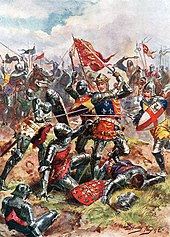 King Henry V at the Battle of Agincourt, fought on Saint Crispin's Day and concluded with an English victory against a larger French army in the Hundred Years' War
King Henry V at the Battle of Agincourt, fought on Saint Crispin's Day and concluded with an English victory against a larger French army in the Hundred Years' War
A dispute over the succession to Edward led to an unsuccessful Norwegian Invasion in September 1066 close to York in the North, and the successful Norman Conquest in October 1066, accomplished by an army led by Duke William of Normandy invading at Hastings late September 1066.[45] The Normans themselves originated from Scandinavia and had settled in Normandy in the late 9th and early 10th centuries.[46] This conquest led to the almost total dispossession of the English elite and its replacement by a new French-speaking aristocracy, whose speech had a profound and permanent effect on the English language.[47]
Subsequently, the House of Plantagenet from Anjou inherited the English throne under Henry II, adding England to the budding Angevin Empire of fiefs the family had inherited in France including Aquitaine.[48] They reigned for three centuries, some noted monarchs being Richard I, Edward I, Edward III and Henry V.[48] The period saw changes in trade and legislation, including the signing of the Magna Carta, an English legal charter used to limit the sovereign's powers by law and protect the privileges of freemen. Catholic monasticism flourished, providing philosophers, and the universities of Oxford and Cambridge were founded with royal patronage. The Principality of Wales became a Plantagenet fief during the 13th century[49] and the Lordship of Ireland was given to the English monarchy by the Pope. During the 14th century, the Plantagenets and the House of Valois claimed to be legitimate claimants to the House of Capet and of France; the two powers clashed in the Hundred Years' War.[50] The Black Death epidemic hit England; starting in 1348, it eventually killed up to half of England's inhabitants.[51]
Between 1453 and 1487, a civil war known as the War of the Roses waged between the two branches of the royal family, the Yorkists and Lancastrians.[52] Eventually it led to the Yorkists losing the throne entirely to a Welsh noble family the Tudors, a branch of the Lancastrians headed by Henry Tudor who invaded with Welsh and Breton mercenaries, gaining victory at the Battle of Bosworth Field where the Yorkist king Richard III was killed.[53]
Early modern period
The Tudor period saw the gradual evolution of England's medieval army into a larger force supported by powerful ships and gun forts.[54] Under the Tudor dynasty, art and commerce flourished. England began to develop naval skills, and exploration intensified in the Age of Discovery.[55] Henry VIII broke from communion with the Catholic Church, over issues relating to his divorce, under the Acts of Supremacy in 1534 which proclaimed the monarch head of the Church of England. In contrast with much of European Protestantism, the roots of the split were more political than theological.[c] He also legally incorporated his ancestral land Wales into the Kingdom of England with the 1535–1542 acts. There were internal religious conflicts during the reigns of Henry's daughters, Mary I and Elizabeth I. The former took the country back to Catholicism while the latter broke from it again, forcefully asserting the supremacy of Anglicanism. The Elizabethan era is the epoch in the Tudor age and the reign of Elizabeth I ("the Virgin Queen"). Historians often depict it as the golden age in English history that represented the apogee of the English Renaissance and saw the flowering of great art, poetry, music and literature.[57][58]
King Henry VIII (1491–1547)
Queen Elizabeth I (1558–1603)
Competing with Spain, the first English colony in the Americas was founded in 1585 by explorer Walter Raleigh in Virginia and named Roanoke. The Roanoke colony failed and is known as the lost colony after it was found abandoned on the return of the late-arriving supply ship.[59] With the East India Company, England also competed with the Dutch and French in the East. The East India Company would become the most powerful corporation in history.[60][61] England was also at war with Spain. An armada sailed from Spain in 1588 as part of a wider plan to invade England and re-establish a Catholic monarchy. The plan was thwarted by bad coordination, stormy weather, and better employment of naval guns and battle tactics by the English fleets.[62] This failure did not end the threat: Spain launched two further armadas, in 1596 and 1597, but both were driven back by storms. England during this period had a centralised, well managed, and effective government after vast Tudor reforms.[63]
Union with Scotland
Further information: Union of the Crowns and Treaty of Union
The political structure of the island changed in 1603, when the King of Scots, James VI, a kingdom which had been a long-time rival to English interests, inherited the throne of England as James I, thereby creating a personal union.[64] He styled himself King of Great Britain, although this had no basis in English law.[65] Under the auspices of James VI and I the Authorised King James Version of the Holy Bible was published in 1611. It was the standard version of the Bible read by most Protestant Christians for four hundred years until modern revisions were produced in the 20th century.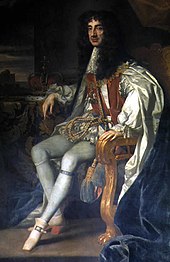 The English Restoration restored the monarchy under King Charles II and peace after the English Civil War.
The English Restoration restored the monarchy under King Charles II and peace after the English Civil War.
Based on conflicting political, religious and social positions, the English Civil War was fought between the supporters of Parliament and those of King Charles I, known colloquially as Roundheads and Cavaliers respectively. This was an interwoven part of the wider multifaceted Wars of the Three Kingdoms, involving Scotland and Ireland. The Parliamentarians were victorious, Charles I was executed and the kingdom replaced by the Commonwealth. Leader of the Parliament forces, Oliver Cromwell declared himself Lord Protector in 1653; a period of personal rule followed.[66] After Cromwell's death and the resignation of his son Richard as Lord Protector, Charles II was invited to return as monarch in 1660, in a move called the Restoration. With the reopening of theatres, the Restoration spectacular ushered in an renaissance of English drama and performing arts.[67] After the Glorious Revolution of 1688, it was constitutionally established that King and Parliament should rule together, though Parliament would have the real power. This was established with the Bill of Rights in 1689. Among the statutes set down were that the law could only be made by Parliament and could not be suspended by the King, also that the King could not impose taxes or raise an army without the prior approval of Parliament.[68] Also since that time, no British monarch has entered the House of Commons when it is sitting, which is annually commemorated at the State Opening of Parliament by the British monarch when the doors of the House of Commons are slammed in the face of the monarch's messenger, symbolising the rights of Parliament and its independence from the monarch.[69] With the founding of the Royal Society in 1660, science was greatly encouraged.
In 1666 the Great Fire of London gutted the city of London, but it was rebuilt shortly afterward with many significant buildings designed by Sir Christopher Wren.[70] By the mid-to-late 17th century, two political factions had emerged – the Tories and Whigs. Though the Tories initially supported Catholic king James II, some of them, along with the Whigs, during the Revolution of 1688 invited the Dutch Prince William of Orange to defeat James and become the king. Some English people, especially in the north, were Jacobites and continued to support James and his sons. Throughout the Stuart era, England expanded in trade, finance and prosperity. Art, literature, and enlightenment ideas flourished. The enlightenment had come early to England, producing philosophers such as John Locke. The Royal Navy developed Europe's largest naval fleet.[71] After the parliaments of England and Scotland agreed,[72] the two countries joined in political union, to create the Kingdom of Great Britain in 1707.[64] To accommodate the union, institutions such as the law and national churches of each remained separate.[73]
Late modern and contemporary periods
 The River Thames during the Georgian period from the Terrace of Somerset House looking towards St. Paul's, c. 1750
The River Thames during the Georgian period from the Terrace of Somerset House looking towards St. Paul's, c. 1750
Under the newly formed Kingdom of Great Britain, output from the Royal Society and other English initiatives combined with the Scottish Enlightenment to create innovations in science and engineering, while the enormous growth in British overseas trade protected by the Royal Navy paved the way for the establishment of the British Empire. Domestically it drove the Industrial Revolution, a period of profound change in the socioeconomic and cultural conditions of England, resulting in industrialised agriculture, manufacture, engineering and mining, as well as new and pioneering road, rail and water networks to facilitate their expansion and development.[74] The opening of Northwest England's Bridgewater Canal in 1761 ushered in the canal age in Britain.[75] In 1825 the world's first permanent steam locomotive-hauled passenger railway – the Stockton and Darlington Railway – opened to the public.[75] The Battle of Trafalgar was a naval engagement between the Royal Navy and the combined fleets of France and Spain during the Napoleonic Wars.[76]
The Battle of Trafalgar was a naval engagement between the Royal Navy and the combined fleets of France and Spain during the Napoleonic Wars.[76]
During the Industrial Revolution, many workers moved from England's countryside to new and expanding urban industrial areas to work in factories, for instance at Birmingham and Manchester,[77] with the latter the world's first industrial city.[78] England maintained relative stability throughout the French Revolution, under George III and William Pitt the Younger. The regency of George IV is noted for its elegance and achievements in the fine arts and architecture.[79] During the Napoleonic Wars, Napoleon planned to invade from the south-east; however, this failed to manifest and the Napoleonic forces were defeated by the British: at sea by Horatio Nelson, and on land by Arthur Wellesley. The major victory at the Battle of Trafalgar confirmed the naval supremacy Britain had established during the course of the eighteenth century.[80] The Napoleonic Wars fostered a concept of Britishness and a united national British people, shared with the English, Scots and Welsh.[81]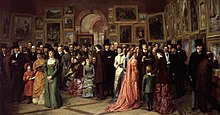 The Victorian era is often cited as a Golden Age. Painting done by William Powell Frith to show cultural divisions.
The Victorian era is often cited as a Golden Age. Painting done by William Powell Frith to show cultural divisions.
London became the largest and most populous metropolitan area in the world during the Victorian era, and trade within the British Empire – as well as the standing of the British military and navy – was prestigious.[82] Technologically, this era saw many innovations that proved key to the United Kingdom's power and prosperity.[83] Political agitation at home from radicals such as the Chartists and the suffragettes enabled legislative reform and universal suffrage.[84]
Power shifts in east-central Europe led to World War I; hundreds of thousands of English soldiers died fighting for the United Kingdom as part of the Allies.[d] Two decades later, in World War II, the United Kingdom was again one of the Allies. Developments in warfare technology saw many cities damaged by air-raids during the Blitz. Following the war, the British Empire experienced rapid decolonisation, and there was a speeding-up of technological innovations; automobiles became the primary means of transport and Frank Whittle's development of the jet engine led to wider air travel.[86] Residential patterns were altered in England by private motoring, and by the creation of the National Health Service in 1948, providing publicly funded health care to all permanent residents free at the point of need. Combined, these prompted the reform of local government in England in the mid-20th century.[87]
Since the 20th century, there has been significant population movement to England, mostly from other parts of the British Isles, but also from the Commonwealth, particularly the Indian subcontinent.[88] Since the 1970s there has been a large move away from manufacturing and an increasing emphasis on the service industry.[89] As part of the United Kingdom, the area joined a common market initiative called the European Economic Community which became the European Union. Since the late 20th century the administration of the United Kingdom has moved towards devolved governance in Scotland, Wales and Northern Ireland.[90] England and Wales continues to exist as a jurisdiction within the United Kingdom.[91] Devolution has stimulated a greater emphasis on a more English-specific identity and patriotism.[92] There is no devolved English government, but an attempt to create a similar system on a sub-regional basis was rejected by referendum.[93]
Governance
Politics
Main article: Politics of England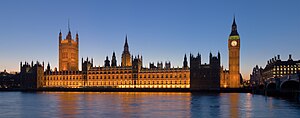 The Palace of Westminster, the seat of the Parliament of the United Kingdom
The Palace of Westminster, the seat of the Parliament of the United Kingdom
England is part of the United Kingdom, a constitutional monarchy with a parliamentary system.[94] There has not been a government of England since 1707, when the Acts of Union 1707,[95] putting into effect the terms of the Treaty of Union, joined England and Scotland to form the Kingdom of Great Britain.[72] Before the union England was ruled by its monarch and the Parliament of England. Today England is governed directly by the Parliament of the United Kingdom, although other countries of the United Kingdom have devolved governments.[96]
In the House of Commons which is the lower house of the British Parliament based at the Palace of Westminster, there are 532 members of parliament (MPs) for constituencies in England, out of the 650 total.[97] England is represented by 345 MPs from the Conservative Party, 179 from the Labour Party, seven from the Liberal Democrats, one from the Green Party, and the Speaker of the House.
Since devolution, in which other countries of the United Kingdom – Scotland, Wales and Northern Ireland – each have their own devolved parliament or assemblies for local issues, there has been debate about how to counterbalance this in England. Originally it was planned that various regions of England would be devolved, but following the proposal's rejection by the North East in a 2004 referendum, this has not been carried out.[93] Although England has not directly devolved from the UK, the devolution of various offices and responsibilities to Scotland and Wales have led over time to various bodies representing England only, such as the Forestry Commission and Planning Inspectorate.[98]

